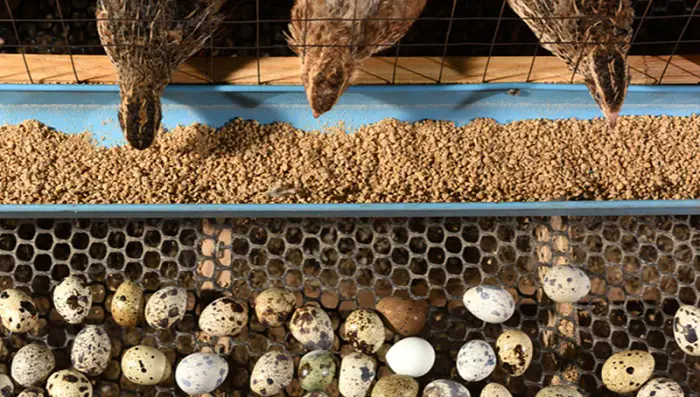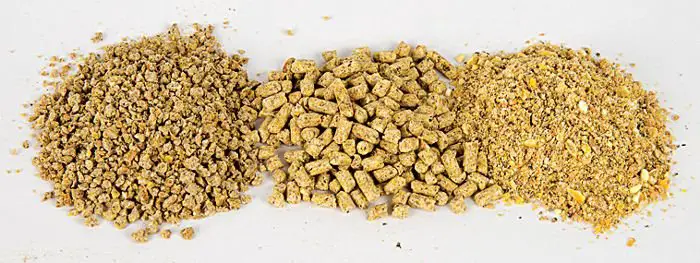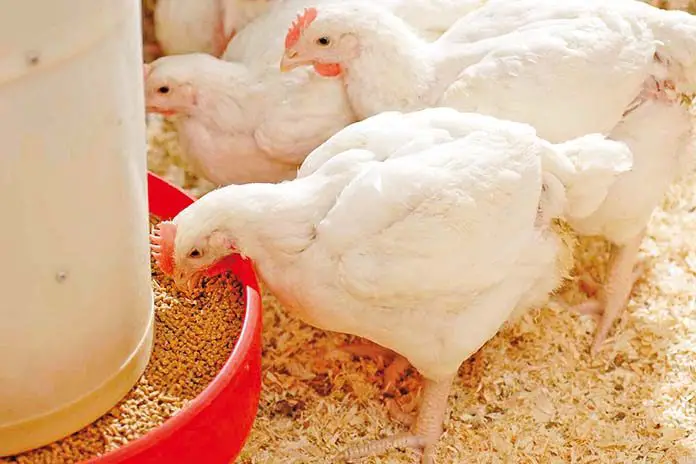Quails are small game birds that have been domesticated for meat and eggs, over 10% of global table egg production is from quails. Quails account for only 0.2% of meat produced, they can also be kept as pets due to their small size and minimal feed requirements of around 20 to 30 grams of feed per bird per day. There are over 70 different domestic breeds or strains of quail but the Japanese or Coturnix quail is the biggest and most common breed kept for eggs and meat. In the wild quail feed on grass seeds, insects, and other plant material producing two clutches of eggs per year determined by feed supply and season. Domesticated quail can produce 300 eggs in a year hence need good nutrition to support this productivity.
Contents
Factors Affecting Quail Egg Production
Many factors affect the egg productivity of quails mainly nutrition, age at first egg, age of the bird, breed, feed, season, and house management. Quails for egg production should be kept in groups of females two weeks ahead of egg production and conditioned for egg production. If the eggs are going to be used for incubation and hatching of quail chicks one male per every five females should be added to the flock. Quails should not be kept in crowded conditions as this causes stress on them reducing their egg production. The housing should be able to adequately protect the birds from the elements and any predators including domestic cats and dogs. Light has an effect on egg production and it is recommended that the layer quails get between 14-16 hours of light as anything below 12 hours leads to a drop in egg production. If all these factors are catered for feed becomes the next limiting factor for layer quails, feed should be balanced for the following nutrients for the layer quails to be productive:
Protein
Sources of protein include soya bean meal, fish meal, meat, and bone meal, and sunflower. Protein is crucial for the growing bird and also to support egg production as eggs are mostly protein.
Energy
All systems in the body need energy to function, like cell growth and repair, blood transport, and respiration. Quails are grain eaters and thus derive most of their energy from grains like maize, millet, rice, and grain by-products
Vitamins
As implied by the name vitamins are vital elements required by the quails in minimum or small quantities. Vitamins help the bird by strengthening the immunity system and keeping all processes running efficiently like transmission of nerve impulses.
Minerals
One critical mineral required by layer quails is calcium but it works in symbiosis with phosphorus. Calcium is crucial for eggshell production and bone formation in layer quails, and phosphorus works in energy transportation and growth in the body. A balance between calcium and phosphorus needs to be maintained as for example an oversupply of calcium in the feed affects phosphorus absorption and utilization.
Feeding Programs
To get to laying age quails need to be grown out on starter and developer diets so that they build up the frame and body to support egg production. Quails meant for meat are two phases a high protein starter ration and a high energy finisher ration only while quails for eggs are grown out on two diets and then fed a layer feed when they reach maturity. The feed provided should be able to supply the above nutrients and calcium to levels required for normal growth and development. Below are the recommended nutritional requirements for laying quails.
Table 1: Nutritional Requirements of Layer Quails
| Feed | Age (Weeks) | Protein | Calcium | Phosphorus | Methionine |
| Starter | 0-6 | 23.0 | 1.0 | 0.50 | 0.50 |
| Developer | 6-20 | 18.0 | 1.0 | 0.50 | 0.40 |
| Layer | 20+ | 19.0 | 2.75 | 0.65 | 0.50 |
Following the above requirements one can come up with a good layer diet provided the feed is made from high-quality raw materials. Using poor-quality raw materials will produce inferior feed and also expose the birds to harmful substances like mycotoxins from moldy grain. Below is an example of a layer quail diet.
Table 2: Quail Layer Diet
| Raw Material | Percentage Inclusion |
| Maize | 42.8 |
| Soya Bean Meal | 41.7 |
| Palm Kernel Cake | 2.0 |
| Wheat Bran | 4.0 |
| Limestone | 4.0 |
| Di-Calcium Phosphate | 4.0 |
| Methionine | 0.3 |
| Lysine | 0.2 |
| Premix | 0.5 |
| Salt | 0.5 |
Additives
To improve the growth, health, and reproductive performance of quails several additives can be added to the layer feed. Antibiotics that help protect the quails from diseases like coccidiosis, coccidiostats, are added to the feed at prophylactic levels to young quail feed. To boost egg production probiotics can also be added to the layer feed which also has the added benefit of improving eggshell quality. Quail eggs are known for their health benefits and to further enhance their omega 3 fatty acid levels the feed can have added levels of omega 3 fatty acid from fishmeal or other sources. Oyster shells are sometimes added to quail layer feed to improve eggshell quality.
Feed Presentation
Most poultry layer feeds are in mash form which makes the production feed a bit cheaper than the starter rations which are normally in the form of crumbles. For quails, crumbles are recommended although some producers will feed small pellets, both presentations reduce wastage as quails are messy eaters. Crumbles are the ideal size for quails which improves consumption and productivity, if pellets are fed care should be taken to observe the birds and crush the pellets if consumption is low. Crumbles are less dusty than mash and do not stick to the quails’ legs which can cause foot rot.
Alternatives Layer Feeds for Quails
If commercial quail layer feed is not available chicken and turkey layer feed without coccidiostats can be fed to quail without any effect on egg production. Any feeds that quails in the wild naturally eat can also be used as supplements rather than actual alternatives to a balanced diet, like leafy vegetables, berries, and seeds.
Conclusion
Quail layer feed should be tailored to grow the young bird into a productive adult and be able to support egg production without compromising the health and well-being of the bird. Quality feed comes from choosing the right raw materials and mixing them in the right proportions.




